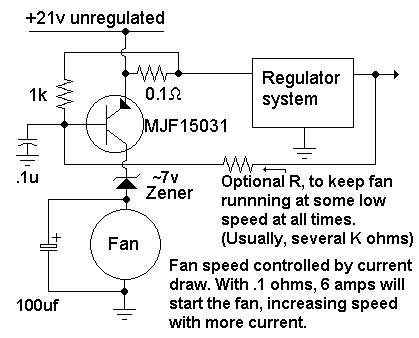
|
Back to Projects Back to Home |
Current-sensing Fan Control By Willie Barnett N1NKM |
Background:
Most power supplies and radios can benefit from cooling fans, but most fans make a lot of noise when running at full speed. You only need a lot of cooling when the radio is transmitting and generating heat. The rest of the time the fan can run much slower, if it runs at all. So I designed a fan control circuit that adjusts the fan speed based on the amount of current being supplied to the radio. When it's transmitting, the radio draws a lot more current and the fan speeds up. When it's receiving, the fan slows down. This circuit can be added to virtually ANY linear regulator power supply, such as an Astron or Pyramid. It is not suitable for use with a switching supply. My design goals were to make it as simple as possible, yet still have the features mentioned above. This circuit meets those goals nicely.

Disclaimer and Warning:
This modification is made INTERNAL to the user's power supply. Hazardous high voltage and high current is present inside the supply. Such modifications should ONLY be done by persons competent to do them. Doing so will VOID any warranty.
User-Selectable Components:
The value of the optional "idle" resistor is to be determined by the user; the type of fan and its current draw will affect this. Typical values would be 5-50k ohms. The ideal speed would be just a little faster than the "stall" speed, so it's always spinning quietly during low-current draw, like receive. A "negative" thermistor (meaning its resistance decreases with temperature) can be used in series with this resistor, to "hold" the fan at a higher RPM when things get warmer. This works quite well. The fan goes up to full when transmitting, and drops back to idle on receive. The fan idles noticeably faster when the heat sinks are warm, and slows down as they cool. The thermistor I used is about 200 ohms at room temp, and drops down to a few ohms when too hot to touch.
Initially this circuit was designed for a power supply capable of not more than 9 amps peak. The radio draws 8A, so we're good - within limits - albeit on the high side. I actually paralleled four 0.33 ohm resistors to get the right voltage drop for the 8A radio, so it's actually close to 0.08 ohms. I used a 0.1 ohm resistor in a smaller supply for a different project.
The value of the 0.1 ohm resistor can be changed as needed. Using Ohm's law, you want it to have a 0.6v drop at the current level where you want the fan to start speeding up. You must also figure the power dissipation of this resistor: 20 amps flowing through a 0.1 ohm resistor is only a 2 volt drop but this also generates 40 watts of heat!
For a 20A system, you would want about 0.033 ohms of resistance. I just paralleled three 0.1 ohm resistors such that 20A would produce about 0.66V drop. Perfect. Just parallel as many 0.1 ohm resistors as you need for the expected operating current. Even at 0.033 ohms, it still dissipates 13 watts.
The 1k resistor value can also be changed, to affect how quickly the fan increases speed as the current rises. A smaller value means the fan will reach its maximum speed sooner, once the desired current value is met. A larger value means the speed "follows" the current draw somewhat more linearly. This value can also be experimented with for best results, based upon fan current, power supply voltage, etc. The zener diode simply prevents a 12v fan from seeing 21 or more volts! This diode must be capable of passing the fan current, so you may need a 2-5 watt component.
Improvements and Alternate Designs:
Because the full fan current must run through the zener diode, you can eliminate the zener diode by adding a couple more parts. For example, running the fan from the power supply's output voltage will automatically limit the fan voltage to about 13 volts. See this small PDF file for schematics. These circuits have NOT been tested; they are theoretical only.
Contact Information:
The author can be contacted at: n1nkm2 [ at ] aol [ dot ] com.
Back to the top of the page
Back to Projects Index page
Back to Home
This web page created 17-May-2016
This web site, the information presented in and on its pages and in these modifications and conversions is © Copyrighted 1995 and (date of last update) by Kevin Custer W3KKC and multiple originating authors. All Rights Reserved, including that of paper and web publication elsewhere.